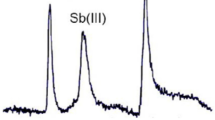Abstract.
Recent achievements in speciation studies of trace elements in the biological and environmental sciences by nuclear analytical techniques, mainly molecular activation analysis, position-sensitive spectrometry with a variety of exciting sources, and synchronous radiation-based analytical techniques (although radioisotope or enriched stable isotope-based speciation techniques are also used), particularly in our laboratory, are outlined. In this paper the merits and drawbacks of the nuclear analytical techniques are discussed, as are reagent blanks, contamination, and artifacts.
Similar content being viewed by others
Author information
Authors and Affiliations
Additional information
Electronic Publication
Rights and permissions
About this article
Cite this article
Chai, Z., Mao, X., Hu, Z. et al. Overview of the methodology of nuclear analytical techniques for speciation studies of trace elements in the biological and environmental sciences. Anal Bioanal Chem 372, 407–411 (2002). https://doi.org/10.1007/s00216-001-1218-2
Received:
Revised:
Accepted:
Published:
Issue Date:
DOI: https://doi.org/10.1007/s00216-001-1218-2




